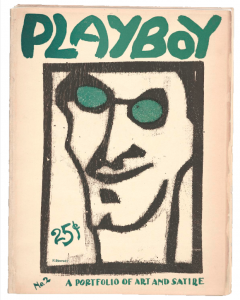
In early 1974, a Chicago book scout named William Ostfeld spotted an early copy of Playboy in the window of a used bookstore — a very early copy.
The magazine, which was about the size of an issue of LIFE, showcased on its cover a woodcut of Hugh Hefner, who had launched Playboy in 1953. Puzzled, Ostfeld opened the brittle cover to look inside. That’s when he saw the publication date: 1919.
What the hell?
In 1914, 26-year-old Egmont Arens (“Eggie” or “E.A.” to friends) returned to New York City with dreams of becoming a poet. He had been sent to New Mexico as a teenager to recover from tuberculosis, attended college there and worked as a cowboy and newspaper sports editor. In New York he married a fellow poet, Josephine Bell, who would be among those indicted for eight anti-war items published in August 1917 issue of The Masses (its last). [1] Arens submitted his poetry for publication (Collier’s printed one in May 1915 called “The Cool of Night”) and became the managing editor of War?, the magazine of the newly formed Collegiate Anti-Militarism League, which opposed U.S. troops doing military drills on campus in preparation for the Great War.
The partnership with War? did not last. In an undated letter to the League’s president, Arens complained that he had been told he could make the publication “as far removed as possible from the ordinary Peace Tract… a bright and snappy journal.” He offered to help finish the next issue but wanted $100 for his interest before he quit.
In 1917 Arens purchased the Washington Square Bookshop at 27 W. 8th St. in Greenwich Village. He also bought a used letterpress, [2] which he set up in the center of the back room. One of his first projects was a map and tongue-in-cheek guide to Bohemia, The Little Book of Greenwich Village, published in 1918 and apparently reprinted many times. He also published brochures, posters, prints, plays and books.
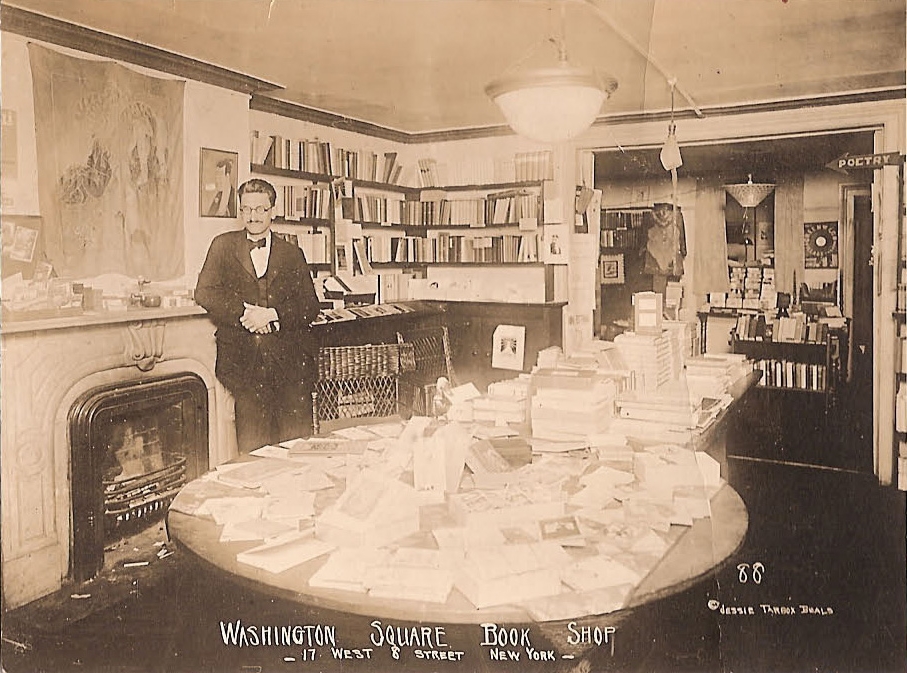
Arens’ disappointment with the stridency of War?— coupled with the conversations among artists and writers who began using the chairs that lined the press room as a salon [3] — likely informed his most ambitious project. [4] By the time the war ended in November 1918, Arens had created letterhead for his venture, and in January 1919, Poetry carried a short announcement: Egmont Arens had launched a new magazine. The title was Playboy, probably after Synge’s The Playboy of the Western World. One critic would later call it the first modern art magazine in America.
In the years immediately after the war, Greenwich Village was teeming with radical optimists. Arens and other young intellects argued that Americans should stop looking to Europe for inspiration and create their own art and identity. America “has heard a great deal of talk about European culture,” he wrote. “She is asking, ‘Is there no American culture?’ ”
While a number of “little magazines” were published in New York in the 1920s, “Joe Klinger’s Pagan and Egmont Arens’ Playboy set the tone for the many Village magazines of the late-war and post-war period: the tone of love talk, estheticism, and faint liberalism all interlarded with mystic symbolism,” wrote Albert Parry in his 1933 history of Bohemianism in America, Garrets and Pretenders. “Playboy was the aristocrat of the Greenwich Village press of the post-war era. It had many of the artists of The Masses, but the spirit of the revolutionary was manifestly absent. The period was first one of disillusionment, and then of prosperity; and the magazine resplendent with dazzling colors and fine paper. But the horseplay and the crazy-cat antics dominated even the beautiful Playboy. The new leader was irresponsibly called ‘Eggplant’ Arens, even in print,” so named because of his perceived passive intellect. [5]
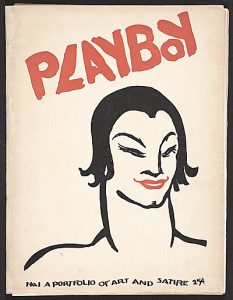
The men and women who agreed to contribute to Playboy were a Who’s Who of Bohemia, including Rockwell Kent, William Gropper, Lola Ridge, Vachel Lindsay, Louise Bryant, Max Weber, Alfred Kreymborg, Djuna Barnes, D.H. Lawrence, Ben Hecht, Horace Brodsky, Mina Loy, Ethel Plummer, John Storrs, Alfred Frueh, William Zorach, Paul Gauguin, Paul Thevenaz, George Bellows, Alexander Brook, Alfred Stieglitz, Hunt Diedrich, Georgia O’Keeffe, Sherwood Anderson, Edmund Wilson Jr., John Dos Passos, James Joyce and E.E. Cummings.
In promoting his creation, Arens wrote:
“No magazine in America has heretofore succeeded in being both alive and modernly beautiful. The humorous magazines have lacked art. The art magazines have been dull and old-fashioned. Now with weapons of art & satire comes a Playboy to fight the fight of the Moderns, to fight with laughter, not bitterness, for the work of this our generation. Finally, now a periodical free of puritanical suppressions, with somewhat the flavor of the European magazines, yet possessed of wholesome vigor which is essentially American.” [6]
Arens’ marriage to Josephine was faltering, and by late 1919 he was sending issues of Playboy to a paramour in Kentucky, Camille Davied, whom he claimed to have fallen in love with after meeting her twice for a total of 12 hours. [7] He signed his letters “Playboy” and said of the magazines, “Don’t show this to the Kentucky folks!” On 10 Dec. 1919, Camille wrote back:
Your “Playboys” have been the center of a heated discussion. Edie, my Dresden China little sister, with her mouth full of pins and her lap full of pink evening dress, and her retrouseé nose more retrouseé than ever, hates it quite emphatically. Edie generally hates what she hates with emphasis. The drawing, according to her, is out of line and the poetry revolting. Modern art is neither beautiful nor useful, and has no excuse whatsoever for existence. The etchings, which are lovely, only please her. Alma thinks it has a “heady” effect like mixed drinks. And nice Mary Morris of Virginia, who is studying illustrating, says that the wood and linoleum block cuts are masterly studies in design…. I think I must like it very much I find myself defending it so vehemently.
Soon after Arens wrote to Davied:
It just occurs to me to send you copies of two letters I wrote to would-be contributors to Playboy. People seem to think that because I sometimes publish poems which are quite frank that I will also publish poems which are riské [sic]. One man wrote me, “Please don’t use my name, as I am not naturally naughty.” I sent his poems back right away after that, because I didn’t want to publish any poems about which the author had that kind of sentiment.
Playboy lasted for eight issues [8] — the first five in 1919, one in 1921 and two in 1923 after Arens had become the art editor of Vanity Fair.

Funding the magazine was a continuing challenge. In Issue 2, Arens noted to readers that “to function properly as an Art Magazine, Playboy must have color plates. The high cost of process printing puts this out of the reach of a twenty-five cent magazine.” He encouraged readers to donate to what he called the “Playboy Fund” by sending him checks. Issues 4 and 5 were published as a double number to save money on paper, and in 1923 he organized subscriber-only dances to raise funds.
In December 1925, the New Yorker noted that a group of five editors, including Arens, hoped to revive The Masses as New Masses. “From what I hear,” reported the New Yorker wag, “the new paper is very pleasing to the eye, printed throughout in three colors, with forty per cent of its pages reserved for cartoons, decorations and the higher art. To make this possible, Egmont Arens, once with Vanity Fair — note how times change — is to stamp it with his genius and print it on his own press, the press that prints the Playboy Magazine. Certainly Mr. Arens has had great experience in getting out periodicals worth looking at, and will do well with this new thing if anybody can.”
In 1927 Arens became managing editor under Rockwell Kent of a new magazine, Creative Arts. While there, he apparently toyed, perhaps with Kent’s encouragement, with reviving Playboy. Notes preserved in his papers at Syracuse University on the back of Creative Arts letterhead show him playing around with subtitles – “Playboy: A Picture Magazine of People’s Play” and “Playboy: A Magazine of Gaiety.” It would be “devoted to the Recreations,” including theater, dance, Harlem and art galleries but also winter sports in Canada and the North, automobiles, flying, the country home, gardening, women’s fashion and men’s wear.
Egmont Arens’ Playboy
No. 1 – January 1919
No. 2 – March-April 1919
No. 3 – Spring 1919
No. 4-5 – Summer-Fall 1919
No. 6 – Winter 1919
No. 7 – Spring 1921
No. 8 (Vol. 2, No. 1) – March 1923
No. 9 (Vol. 2, No. 2) – July 1923
“This magazine would feature PICTURES of things,” he wrote. “It would be a magazine to be looked at. The reading matter would be secondary in importance. The editorial staff would consist of artists and photographers rather than writers.” Further, he wrote, it would be “a magazine that assumes that there is some fun to be had. Anything but bored.”
Notably, it would need “sex appeal,” which would be found in “pictures of beautiful actresses taken by our own photographers. Each photo used, however, must conform to a high artistic standard.” There also would be “reproduction of works of art” and “drawings of gay scenes of sport and nightlife in which sex is subtly played up as in Jugend [a German art magazine] and La Vie Parisienne [a risqué French weekly], but less broadly, to conform to Am[erican] Taste.” In pencil he had notated the page: “Photo girl blowing smoke rings.”
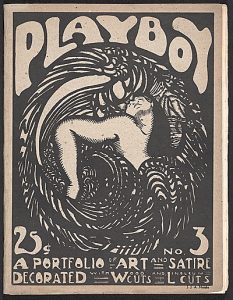
By the end of the decade, Arens had left publishing for a new career at Calkins and Holden, where in 1929 he became the agency’s first director of industrial styling. In 1935 he founded his own design firm, which by the mid-1940s had grown to include 30 employees. Among other assignments, he would design the iconic KitchenAid mixer, the Eight O’Clock Coffee packaging and the Hobart meat slicer. That, and his pioneering of streamlined design and “consumer engineering,” is what he is remembered for.
After William Ostfeld, the Chicago book scout, discovered Arens’ magazine, he purchased the issue (No. 2) for $5 and proceeded to make the publication far less obscure by alerting the editors at Genesis, a derivative of Hefner’s Playboy. In May 1974 the magazine reprinted pages from the issue and its cover, noting the happenstance of Hefner’s doppelganger but more pointedly suggesting its rival had stolen the name and inspiration for his more famous magazine.
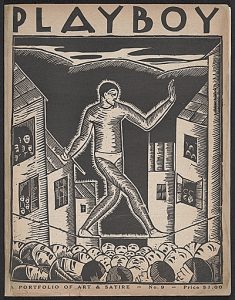
Ostfeld would note with some irritation that the U.S. press largely ignored this revelation. For his part, Hefner has always insisted the name was suggested by a friend during a brainstorming session (rejected titles included Stag Party, [9] Top Hat and Satyrs). Ironically, Hefner’s then-wife didn’t like the title, saying it sounded outdated and made her think of the 1920s. That didn’t bother Hefner, who associated the decade with “high living, parties, wine, women and song – the things we want the magazine to mean.”
There is no record in Egmont Arens’ papers of what he thought of Hefner’s magazine, but he remained proud of his own. Before his daughter Patricia married in 1954, he presented his future son-in-law with a bound set. [10]
Endnotes
[1] Bell’s contribution was a poem in defense of Emma Goldman and Alexander Berkman, who had been imprisoned for opposing the draft. One of her co-defendants, Art Young, recalled that the defense attorney had handed the poem to the judge. “His Honor adjusted his glasses, read it slowly, then handed it back to Mr. Hillquit, saying, ‘Do you call that a poem?’ Mr. Hillquit replied, ‘Your Honor, it is so called in the indictment.’ The judge said, ‘Indictment quashed.’ ”
[2] Arens was discreet about the press. Margaret Anderson, who published a magazine called The Little Review that Arens sold in the shop, had been printing excerpts from James Joyce’s suppressed Ulysses. The Society for the Suppression of Vice took notice after the 13th installment. John S. Sumner, the head of the Society, showed up one day at the bookstore, and he and Anderson argued loudly. Soon after, she was indicted. At about the same time, Arens’ press was printing an anonymous translation of Arthur Schnitzler’s La Ronde (Hands Around), a drama of linked episodes each ending in sex, and Arens was hatching a plan with Rex Stout to publish a 12-volume edition of Casanova’s memoirs illustrated by Rockwell Kent.
[3] Stout, a childhood friend of Josephine Bell, would recall sitting in the shop in 1921 listening for hours as Theodore Dreiser and H.L. Mencken argued politics with “crusty vigor.”
[4] In a biography of Paul Johnston, who worked for Arens at Flying Stag Press, he said that “it was because of [Jo Bell’s] interest in poetry that Playboy was published.” (See Mary Clark, Tally: An Intuitive Life.)
[5] The chapter of Parry’s book that mentioned Playboy had first been published in The American Mercury in 1931, after which Arens wrote H.L. Mencken to offer a follow-up article “extolling the spirit that animated its publication.” Mencken politely declined.
[6] This was in many ways similar to the manifesto Hugh Hefner published in the first issue of his Playboy in 1953. “If you like your entertainment served up with humor, sophistication and spice, Playboy will become a very special favorite…. Affairs of state will be out of our province. We don’t expect to solve any world problems or prove any great moral truths. If we are able to give the American male a few extra laughs and a little diversion from the anxieties of the Atomic Age, we feel we’ve justified our existence.”
[7] Arens and Josephine divorced in 1923. That same year he married his second wife. They divorced in 1930 and seven days later he married Camille Davied. They had a daughter, Patricia, and divorced in 1952. Arens’ fourth wife, Matilde Zwilling, survived him.
[8] The Playboy subscriber cards for 1919, 1920 and 1921 are in Arens’ papers at Syracuse University and include more than 250 names. About a third are from New York but there are also requests from Cuba, Japan, France and China. As part of their divorce settlement, Arens sold the bookshop to Josephine for $1. They remained friendly. In an undated letter, she sent him a listing for “an interesting item that came to us in the mail today. Just thought you would like to see it. 1919 & 1923 – when was that time?” It was a dealer listing for seven issues of Playboy, “an important magazine of protest,” for $29.50.
[9] This title was abandoned when Stag magazine threatened legal action. Notably, at the same time he launched Playboy in 1919, Arens’ established an imprint called The Flying Stag Press.
[10] In a letter dated 25 April 1954, W.P. Cumming wrote Arens: “One of the first things that Ted showed me in his rooms in Cambridge were the bound sets of The Playboy which you had generously given him. He told me how you had edited, published and printed it, and showed me the since-famous names whose early writing was there.” In 1935 Arens wrote to a friend that he had found 16 complete sets and 139 loose issues in storage on East 18th Street. Single issues typically sell today for $300 to $500.
From The Ephemera Journal, September 2017